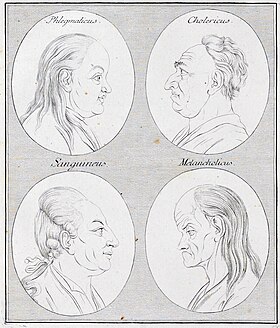Personality tests
| Personality test | |
|---|---|
| Medical diagnostics | |

The four temperaments as illustrated by Johann Kaspar Lavater
|
|
| MeSH | D010556 |
A personality test is a questionnaire or other standardized instrument designed to reveal aspects of an individual's character or psychological makeup.
The first personality tests were developed in the 1920s and were intended to ease the process of personnel selection, particularly in the armed forces. Since these early efforts, a wide variety of personality tests have been developed, notably the Myers–Briggs Type Indicator (MBTI), the Minnesota Multiphasic Personality Inventory (MMPI), and a number of tests based on the five factor model of personality, such as the Revised NEO Personality Inventory.
Estimates of how much the industry is worth are between $2 and $4 billion a year. Personality tests are used in a range of contexts, including individual and relationship counseling, career counseling, employment testing, occupational health and safety and customer interaction management.
The origins of personality testing date back to the 18th and 19th centuries, when personality was assessed through phrenology, the measurement of the human skull, and physiognomy, which assessed personality based on a person's outer appearances. Sir Francis Galton took another approach to assessing personality late in the 19th century. Under the assumption of the lexical hypothesis, Galton estimated the number of adjectives that described personality in the English dictionary Galton's list was eventually refined by Thurstone to 60 words that were commonly used for describing personality at the time. Through factor analyzing responses from 1300 participants Thurstone was able to reduce these sixty adjectives into five common factors. This procedure of factor analyzing common adjectives was later utilized by Raymond Cattell who likewise produced a data set that eventually showed a five factor structure. Work by numerous other researchers over the proceeding decades produced additional support for the five factor structure. McCrae and Costa operationalized these five factors of personality into the measure known as the NEO-PI, one of the most well used versions of the five factor model.
...
Wikipedia
